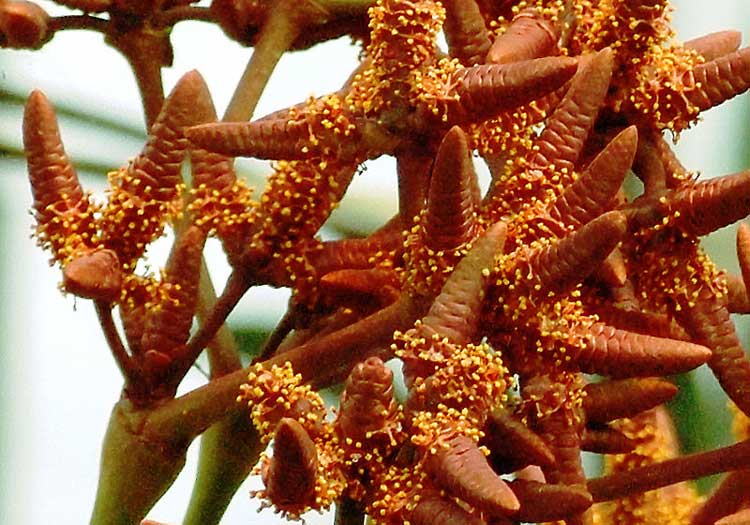Welwitschia mirabilis (*) Cladus: Eukaryota Name Welwitschia mirabilis Hook. f. References * Bustard, L. 1990. The ugliest plant of the world: the story of Welwitschia mirabilis. Kew Magazine 7:85-90. Vernacular names --- Welwitschia is a monotypic genus of gymnosperm plant, composed solely of the very distinct Welwitschia mirabilis. It is the only genus of the family Welwitschiaceae, in the order Welwitschiales, in the division Gnetophyta. The plant, which is considered a living fossil,[1][2] is named after the Austrian botanist Friedrich Welwitsch who discovered it in 1859. The geographic distribution of Welwitschia mirabilis is limited to the Namib desert within Namibia and Angola. Biology Welwitschia grows from a short, thick, woody trunk, with only two leaves that continuously grow from their base, and a long, thick taproot. After germination, the cotyledons grow to 25–35 mm in length, and are followed shortly afterward by the appearance of two permanent leaves. These leaves are produced opposite of the cotyledons, and continue to grow throughout the entire life of the plant. They eventually grow to a length of 2–4 m and usually become split into several strap-shaped sections, thus sometimes disguising the origin from only two leaves. After these appear, two cotyledonary buds appear; in these, the growing tip dies, causing elongation of the buds. Growth continues sideways, which forms the obconical growth of the stem. The species is dioecious, with separate male and female plants. Fertilization, that is, the transfer of the pollen from the male to the female strobili, is carried out by insects that are attracted by "nectar" produced on both male and female strobili.[3] The age of the plants is difficult to assess, but they are very long-lived, living 1000 years or more. Some individuals may be more than 2000 years old. The plant absorbs water through structures on its leaves, harvesting moisture originating from dew that forms during the night. It is possible that W. mirabilis uses Crassulacean acid metabolism (CAM) photosynthesis; if this were true, W. mirabilis would be the only known gymnosperm to do so. However, the evidence is contradictory.[4] Although considered endangered due to its very slow growth and despite the fact that older plants are often sought by collectors, a fair number of plants exist in the wild. The plants living in Angola are better protected than the plants in Namibia, owing to the relatively high concentration of landmines in Angola, which keep collectors away . The species grows readily from seed, which may be purchased from specialty seed dealers. The seed must be kept moist for the first couple of weeks and exposed to as much heat and light as possible during this time. Seeds collected from the wild are often heavily contaminated with spores of Aspergillus niger, which causes them to rot shortly after they germinate. Seeds from the Kirstenbosch National Botanical Garden in Cape Town, South Africa, or other cultivated sources are much cleaner and less likely to rot. Heraldry The plant figures as a charge in the national coat of arms of Namibia, as well as that of Westelike Rugby Subunie. References 1. ^ Flowering Plants of Africa 57:2-8(2001) Source: Wikispecies, Wikipedia: All text is available under the terms of the GNU Free Documentation License |
|

